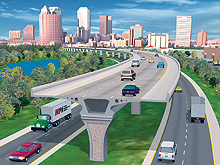
honolulutraffic.com
seeking cost-effective ways to reduce traffic congestion in Honolulu
Why our $7.1 billion rail cost is right:
Here’s why we believe that our estimate of $7.1 billion is a better estimate than the City’s $5.1 billion for the full corridor alignment (both include 33 percent allowances for cost overruns and contingencies).
First, we looked at the Miami Metrorail, which is the only other U.S. modern elevated rail line. We took the cost, increased it for inflation using the same Construction Cost Index that the city uses, and from that arrived at a cost per mile. We then adjusted the cost up 36 percent for Hawaii vs. Florida costs and multiplied the result by the 28 miles of the proposed Honolulu line, added the 30 percent contingency factor and then added in the airport spur. That all amounts to $6.75 billion.
Second, we took Honolulu’s 1992 rail cost in the Final Environmental Impact Statement, which appears to be almost identical to the city administration’s proposed route, but with the addition of Waikele to Kapolei. We then adjusted the cost for inflation using the same Construction Cost Index as the city, divided it by the route miles to arrive at a cost per mile in current dollars. We then multiplied it the length of the “full corridor alignment.” We then added the same 33 percent allowance for contingencies and cost overruns that the city uses. The final total is $6.3 billion.
Third, we took the Tren Urbano line in San Juan and made similar adjustments and came out with a final total of $8.3 billion.
The average of these three is $7.1 billion.
The above is the short version. For a more detailed explanation of all the costs READ MORE